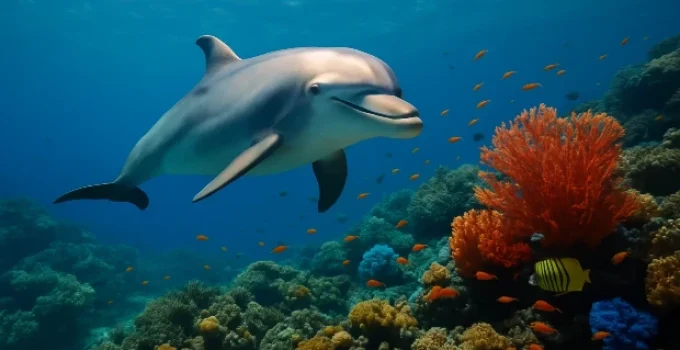⛏️Break It Down
- Do Marine Mammals Breathe Underwater?
- How Do Marine Mammals Breathe?
- Why Don’t Marine Mammals Have Gills?
- How Long Can Marine Mammals Hold Their Breath?
- What Helps Marine Mammals Dive Deep?
- Marine Mammal Breathing Facts Table
- 🎯 Final Thoughts
- 📚 References
Do Marine Mammals Breathe Underwater?
No—marine mammals cannot breathe underwater. Even though they spend most (or all) of their lives in the ocean, they still need to breathe air through lungs, just like land mammals. That means whales, dolphins, seals, manatees, and sea otters must regularly come to the surface to take a breath.
These mammals have adapted special ways to hold their breath for long periods and dive deep, but they still rely on air—not water—for oxygen.
🐋 According to NOAA, marine mammals are classified into four different taxonomic groups: cetaceans (whales, dolphins, and porpoises), pinnipeds (seals, sea lions, and walruses), sirenians (manatees and dugongs), and marine fissipeds (polar bears and sea otters).
How Do Marine Mammals Breathe?
Marine mammals breathe through lungs, just like humans. But instead of noses, many have blowholes on the tops of their heads. These blowholes act like nostrils and open when the animal surfaces.
When they come up for air, they:
- Exhale a strong blast of air (and water vapor) through the blowhole
- Inhale fresh air quickly
- Close the blowhole with a muscular flap before diving again
💨 According to Whale & Dolphin Conservation USA, whales can exchange up to 90% of the air in their lungs in a single breath—humans only exchange about 15%!
Why Don’t Marine Mammals Have Gills?
Marine mammals are not fish. They are warm-blooded animals that evolved from land mammals, so they never developed gills. Gills allow fish to pull oxygen directly from water, but marine mammals must:
- Surface to breathe
- Use lungs to take in air
- Hold their breath while underwater
Even though they live in the ocean, their biology is still mammalian.
🧬 According to Berkley University of California, whales evolved from land-dwelling ancestors about 50 million years ago.
How Long Can Marine Mammals Hold Their Breath?
Marine mammals are breath-holding champions! They can slow their heart rate and store oxygen in their muscles and blood to stay underwater much longer than humans can.
Here are a few record holders:
- Sperm whale: Up to 90 minutes
- Weddell seal: Over 60 minutes
- Dolphin: 8–15 minutes
- Sea otter: About 5 minutes
- Manatee: 15–20 minutes
These adaptations allow them to hunt, swim, and avoid predators deep below the surface.
⏱️ The New York Times reported that a Cuvier’s beaked whale held its breath for 3 hours and 42 minutes—a world record for any mammal!
What Helps Marine Mammals Dive Deep?
Marine mammals have amazing physical traits that help them dive safely:
- Flexible lungs that collapse under pressure and prevent damage
- High myoglobin levels in muscles for oxygen storage
- Slow heart rate (bradycardia) to conserve oxygen
- Shifting blood flow away from organs that don’t need oxygen during a dive
These adaptations allow them to avoid getting “the bends” and stay underwater for long stretches of time.
🩸 According to Scripps Institution of Oceanography, elephant seals carry more than 3X the amount of oxygen for every unit of body mass relative to humans. But they don’t store and carry it as a gas in their lungs. It’s stored in their blood and muscles.
Marine Mammal Breathing Facts Table
| Marine Mammal | Breathing Organ | Max Breath-Hold Time | Has Blowhole? |
|---|---|---|---|
| Sperm Whale | Lungs | 90 minutes | ✅ Yes |
| Bottlenose Dolphin | Lungs | 14 minutes | ✅ Yes |
| Manatee | Lungs | 20 minutes | ❌ No (nostrils) |
| Sea Otter | Lungs | 5 minutes | ❌ No (nostrils) |
| Weddell Seal | Lungs | 96 minutes | ❌ No (nostrils) |
| Cuvier’s Beaked Whale | Lungs | 222 minutes (record) | ✅ Yes |
🎯 Final Thoughts
Do marine mammals breathe underwater? Not at all! These amazing animals must surface to breathe air, even though they’ve adapted perfectly to life in the sea. Using lungs, blowholes, and super breath-holding powers, marine mammals can dive deep and swim long distances—but they always return to the surface for a gulp of fresh air. Nature gave them the best of both worlds!
📚 References
💻National Oceanic and Atmospheric Administration (NOAA). “Marine Mammals.” https://www.noaa.gov/education/resource-collections/marine-life/marine-mammals
💻Whale & Dolphin Conservation USA. “How Do Whales Breathe?” https://us.whales.org/2012/10/20/how-do-whales-breathe/
💻Berkley University of California – UC Museum of Paleontology. “The Evolution of Whales.” https://evolution.berkeley.edu/what-are-evograms/the-evolution-of-whales/
💻The New York Times. “Beaked Whale Shatters Record With 3 Hour 42 Minute Dive.” https://www.nytimes.com/2020/09/23/science/beaked-whale-diving-record.html
💻UC San Diego – Scripps Instution of Oceanography – Earthguide. “Diving the Deep: Elephant Seals.” https://earthguide.ucsd.edu/elephantseals/oxygen/index.html
📌Learn More About Mammals
- When Do Squirrels Hibernate? 🐿️How These Smart Survivors Outsmart Winter
- What Makes an Animal a Mammal? 🐾 The Traits That Set Mammals Apart
- Do All Mammals Have Fur? 🦭 The Fuzzy Facts Behind Mammal Life
- What Does Warm-Blooded Mean? 🌡️ Animals That Bring the Heat (Literally)
- Which Mammals Lay Eggs? 🥚 The Eggstraordinary Rule-Breakers of the Mammal World
